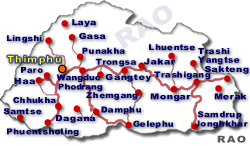 |
Bhutan's
Tourist Destinations |
|
 |
Bhutan Information |
|
|
 |
| Nabji (Trongsa)
to Jangbi (Zhemgang)-Phobjikha (Wangdue
P.) to Kamichuin (Tsirang) |
 |
 |
| The
two routes, from Nabji to Jangbi in Trongsa and Zhemgang and from Phobjikha
to Kamichu in Wangdue and Tsirang were selected for their prominence
as unblemished areas. They are rich in flora and fauna.
The Nabji
to Jangbi trek starts from 1,000 metres and goes up to 1,500 metres
passing through broad leafed sub-tropical forests. It is a one-week trek
and passes through eight villages. The Phobjikha to Kamechu route
is a three-day trek with the route dropping from 2,900 metres to a much
warmer Kamechu at about 600 metres.
On
this route, tourists will be able to see the endangered golden langur,
hornbills and a variety of plants and flowers of which the most abundant
is the Rhododendron. The new routes will also address the seasonality problem
as they are best suited for trekking between November and April, the lean
tourist season. During summer these routes are infested with leeches and
snakes. |
|
The
department of tourism (DoT) and the nature conservation division (NCD)
have identified two trekking routes in western central and central Bhutan
as part of pilot project to develop community tourism in the country. The
two trekking routes will form the basis of a study on developing a proper
framework for community based tourism in consultation with the primary
stakeholders or the community members themselves. Community based tourism
is an approach where the local community is actively involved in its development
and management, are able to derive benefits and enhance income, and promote
conservation of nature and culture.
| The
study indicated that the new routes will also help generate additional
income to the local communities. Locals can run lodges, have campsites
within the villages, provide horses for the tourists and also work as guides
since they would be more familiar with the ecosystem of the place. Most
villagers agreed that rendering services to tourists would fetch them additional
income.; |
 |
But
some villagers in Phobjikha and Kamechu felt that motor roads and electricity
in their villages was more beneficial than leaving their environment untouched
for tourist attraction. "I had a hard time convincing the people about
the benefits of the project," said one of the surveyors.
The
second stage of the project will list down the basic requirement for tourists
in the pilot areas and study the possible socio-economic impact on the
local community. The third and final stage will result in tourists visiting
the selected sites. Karma Tshering said that the main purpose of the project
was to change the outlook of the community towards tourists 'from strangers
to guests'. "And this can only be possible with the involvement of the
community whereby they benefit."Meanwhile the start of the second phase
is yet to be decided.
 |
| Contributed
by Tashi Dorji, KUENSEL, Bhutan's National Newspaper |

|
|
Phobjikha
valley
|
| Information on Bhutan |
 |
|





